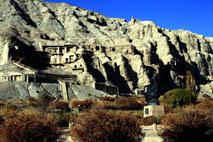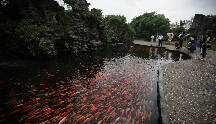Urumqi-- Where Different Cultures Meet
Urumqi, Xinjiang
By staff reporter ZHANG XIWEN
Some 3,000 years ago, certain settlements in present-day Xinjiang Uygur Autonomous Region were sites of prosperous transcontinental commerce, with merchants coming from as far as Greece, Rome and Arabia. Many passed through Xinjiang on their way to China's central plains.
By the second century, this trade was arousing much interest from the Chinese authorities, who believed commercial activities with foreign countries were advantageous in more ways than one: they could make the country richer and the border areas safer. With encouragement from the authorities, more merchants and goods came via the Old Silk Road. About 1,300 years ago, China's political center moved west to present-day Xi'an in Shaanxi Province. This move highlighted the strategic, as well as commercial, significance Xinjiang was to have. In 702, the Tang Dynasty emperor had a fortress built 13 kilometers south of contemporary Urumqi to station his army. Migrants were encouraged, and with an increasing population, the fortress developed into Luntai County, the beginnings of present-day Urumqi.
 |
| Kizil Thousand-Buddha Cave. |
In more recent centuries, the luxuriant grassland around Urumqi attracted nomads from the Mongolian Plateau, who came with their herds to make this place their home. It was common to see Mongolian yurts and cooking fires built on top of three small rocks. Fragrant milk scented the air while herds of livestock grazed on the grasslands. This is how the area gained its name, Urumqi, which means "an ideal pasture."
Over the last 100 years, Urumqi has undergone a rapid transformation, from a place of herdsmen, farmers and traders to a cosmopolitan city. As recently as the early 1950s, herds of sheep could still be seen on the city's roads, and with the exception of the odd government vehicle, cars were rare. In fact, before every government building were hitching posts for people to tie their horses, which were by far the most common form of transport. Today these scenes are long gone. Contemporary Urumqi has a population of 3 million, forests of high buildings, and streams of motor vehicles flowing through its streets.
Some things have remained unchanged though. The city still comprises a diverse culture of 47 ethnic groups, including descendants from the ancient Huns, Turks, Persians, Khitans, and others from the central plains. Different cultures brought different beliefs, and Islam, Christianity, Catholicism, Buddhism and Taoism are all still practiced today. Buddhist temples, mosques, churches and Taoist temples are seen side by side on the same street, the various chants emanating from their interiors creating a multicultural chorus.
Services
Economy
- Eco-agriculture and Eco-tourism Power Nanchang’s Green Development
- Balance Environmental Protection and Economic Prosperity – Nanchang Looks to European Technology for Green Development
- Sustainable Growth Requires Wiser Energy Use
- Chinese Economy: On the Path of Scientific Development
- China's Economy over the Last Ten Years

